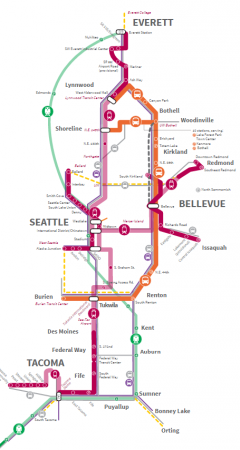Sound Transit 3: What Does It Cost?
 Now that we've itemized three waves of projects that ST3 would deliver (1, 2 ,3), you might wonder how much this project will actually cost. There are a lot of numbers, some of them very large, that have circulated over the last year or so. But how much is it really going to cost?
Now that we've itemized three waves of projects that ST3 would deliver (1, 2 ,3), you might wonder how much this project will actually cost. There are a lot of numbers, some of them very large, that have circulated over the last year or so. But how much is it really going to cost?
I don't want to read this whole article. How much is it going to cost me?
The easiest value to understand is the cost per individual. The median adult in the Sound Transit District will spend about $169 per year, or 46 cents per day. If you have your financial records together, you can use this Seattle Times calculator to compute your individual tax burden. Obviously, this bill will vary over time as car values, taxable spending, and house prices change.
I've used up my seattletimes.com pageviews. How can I compute it?
An annual tax of 0.8% of the assessed value of autos, 0.5% on taxable purchases, and 0.025% of the assessed value of real estate. The last amounts to $100 a year on a $400,000 house.
I've been paying close attention to your series, and all the projects add up to maybe $20 billion. What's this $54 billion figure I see in the paper?
Inflation. The individual project studies are priced in 2014 dollars because the studies aren't attached to any completion date. The reporting convention is that the overall package is quoted in YOE (Year of Expenditure) dollars. The same project costs more when it finishes in 2030 than if it finished in 2025, because the purchasing power of a dollar declines.
You might wonder how you're supposed to have any sense of whether a billion 2040 dollars is a high or low expenditure for infrastructure, and you'd be right. That's why I'm a firm supporter of the individual cost estimates at the top of this article.
I thought the legislature authorized $15 billion in taxes. How can ST afford $20 billion, much less $54 billion?
Once again, this relates to reporting conventions. The original ST3 concept would have completed in 15 years, presumably with many fewer projects. As a shorthand, legislators referred to total tax collections in 15 years as a handle on the size of the package. Even in that case, some of that figure is 2017 dollars and some are 2031 dollars. And as it happened, various amendments to the bill chopped a few percentage points off the sum that Sound Transit can actually realize.
However, the tax was never going to stop after 15 years. In that period, Sound Transit would have sold bonds that it would have paid off with taxes collected after 2031. So overall, it would have been able to fund something like $25 billion of projects.
The last big leap in size occurred when they added projects that would arrive in up to 25 years. This accomplished two things. First, it meant they would accumulate capital for a longer period of time. Second, in the second half of those 25 years most of the ST1 and ST2 bonds expire, freeing up the revenue streams that pay off those bonds.
Sound Transit also expects billions in federal grants, amounting to about 13% of the total capital cost. This is in line with past experience.
So is it worth the money?
ST3 is the most plausible path to deliver wide-ranging alternatives to congestion and to direct growth into more sustainable corridors. We are just now reaping the seeds planted by the generation before us, and have the opportunity to do the same for the next. Whether that outcome is worth the investment is something for each voter to decide, although you'll hear more from us about this soon.